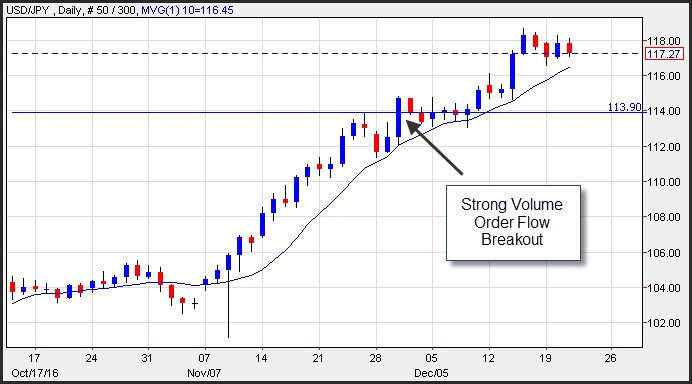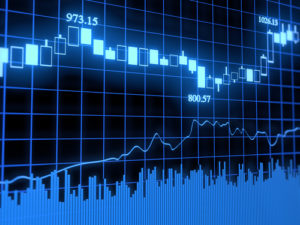 The spot currency market is the largest financial market in the world transacting more than several trillion dollars of turnover every day. Every time you enter a trade into your online trading platform, an order is sent through, and electronically transacted.
The spot currency market is the largest financial market in the world transacting more than several trillion dollars of turnover every day. Every time you enter a trade into your online trading platform, an order is sent through, and electronically transacted.
In some cases, for larger customers, transactions are verbally negotiated. The main players that accept larger orders are the interbank market institutions. Brokers that facilitate individual transactions also have an order flow book. The flow of orders can be very valuable to a market maker or broker, as it describes the underlying momentum associated with the movements in a currency pair.
Forex order flow is driven by the interbank market which makes up approximately half of the notional value of trades that occur daily. Market participants in the interbank space include commercial and investment banks. Since most fx market liquidity is funneled through the interbank market, it is important to analyze how these players use order flow information to help make trading decisions.
Order flow in the forex market is driven by trades that flow through large financial institutions where counterparties range from other sell side players, to buy side customers which include both treasuries, central banks and portfolio managers. The orders that sell side players receive from customers relay important information. The information is so valuable that many times, a sell side player may not charge their customer for these trades in the form of commissions.
Most of the currency order flow trades through approximately 15 sell side financial institutions. These include some of the largest commercial banks, that have dedicated commercial forex desks including Chase, Citi and Bank of America.
What is Order Flow?
Financial institutions have thousands of clients globally who at some point might need to generate a currency transaction. Banks have investment banking and corporate finance clients who are cross sold, which can stretch across the forex environment. These companies will also be active in interest rates, commodities, equities market making.
The key to using order flow trading is to determine market depth. This describes the exchange rates where customers want to transact. The order flow is like a list of trades that will take place as the market moves. Since many of a bank’s corporate clients are relatively price indifferent and not trying to extract every pip from the market, they will leave their dealer a level where they feel comfortable executing their trade. This is a limit order, but can also be a stop order if the client is attempting to enter a trade on a break out.
Trading order flow allows a dealer to see the specific price where a trade will hit the market along with the volume of that trade. This information is extremely valuable and allows a dealer to generate substantial revenue by using this information to trade.
The dealers order flow would show each level where a transaction could take place along with what is on each side of the ledger. The size of each trade is listed along with the volume of trades. Each order flow book is different and shows you the volume along with the price. For example, the EUR/USD trader would have a different order flow book then the USD/JPY trader.
Most dealers use their order books to their advantage or their situation. Obviously, there will be a range of trades that a dealer will see within the forex institutional order flow. This does not mean that a trader can front run a trade, as the customer nearly always has the option of canceling the trade if the exchange rate has not reached the trigger level.
So, if a dealer decided they want to short the EUR/USD currency pair 5 pips before a trigger is reached to sell a large volume of that currency, and the order is canceled just before the level is reached, the dealer might be stuck in a trade that is moving in the wrong direction.
An order book will generally see large volume trades further away from the spot price and many smaller volume trades near the currency spot price. Many times, a sell side dealer will base some of their risk management around their order book. For example, if there are large sell orders above the current exchange rate, a dealer could use those levels as potential resistance.

Many traders will use forex order flow analysis to help with the direction of their traders and confirmation that the market is moving in a specific direction. If there is order flow in the direction of a move as the market is technically breaking out, a dealer could jump on to a trade that is moving.
For example using the image above, if a dealer has a hedge fund client that has a buy stop order to purchase a large quantity of USD/JPY at the 113.90 level, the dealer could purchase more volume than they need to cover their position. So, if the client is looking to purchase 30 million dollars of USD/JPY, the dealer might purchase 40 million, and catch the move higher as prices technically break out.
While the order flow book is extremely valuable, there will be times when it will not work as customers are aware of how an order flow can benefit a dealer. A hedge fund might decide to enter a position with one dealer and exit that position with another. While these scenarios might incur additional credit use, it can be unwound a few days later, making it so neither dealer understands exactly what their customer was doing.
Sell side dealers understand how to use order flow, and the difference between using an orderbook when the market is moving and using it when it’s unlikely to move. For example, is a bank does a large trade with a corporate treasurer, they understand that the trade was not geared to generate revenue.
Dealers will at times have overlapping order flow as a customer decides to trade in a cross pair. While dealers have cross pair trades, most of the liquidity is in the major currency pairs. For this reason, a EUR/USD trader might have an offsetting dollar trade to the USD/JPY trader. In this instance, it is important that traders within the same sell side shop communicate their order flow to one another.
Most sell side financial corporations that deal in the forex markets have a couple of dealers per location per currency pair. There is usually a primary and secondary dealer. Most of the time the order book is passed around the globe. For currencies that are generally only liquid in a specific time zone the order book is generally not passed.
Forex dealers attempt to capture gains by purchasing a currency pair on the bid and selling the pair on the offer. This allows the dealer to capture the bid/offer spread. For currency pairs that are very liquid such as the EUR/USD the bid offer spread could be a narrow as half of a pip, while on some exotic currency pairs the bid offer spread could be even 20 pips wide.
Gauging Sentiment Using Volume
The volume of order flow is difficult to gauge if you are not a currency dealer. Most dealers have access to over the counter dealing platforms such as Electronic Broking Services (EBS) and Thomson Reuters Dealing.
This allows them to create internal order flow indicators. If you are a retail client you will not be able to evaluate this order flow process but can find a different mechanism for gauging flow. Currency market volume is hard to measure, but you can measure the volume seen in futures and ETFs as well as the options on these products.
Volume Using Futures Contracts
Volume in the futures markets describes the total trading activity in a specific contract. Futures contracts on currency pairs can be very liquid and arbitraged by dealers to make sure their values are identical to the value in the OTC market. If the volume is increasing at a specific level and time, it can be used just as the dealer uses the deal flow. The difference is you cannot see it in advance, you must determine if the volume pushed a currency pair higher or halted its progress once the volume is transacted.
You can also use volume in tandem with open interest to measure sentiment. Open interest describes the total number of contracts that are open. This number is updated at the end of a trading session while volume is generally updated during a trading session. If volume is greater than open interest, you know the trade is new. If it is less than open interest it is hard to determine if the trade is new or an unwind of a position. Generally rising volume and rising open interest is a confirmation of a new position where rising volume and falling open interest is the liquidation of a prior position.
Options Volume
You can also evaluate the options volume on both futures and ETF’s to see orders that have moved through the market and are generating momentum. When there is unusual activity in the options market, this could be the case. Unusual activity is described as more than 200% volume relative to the volume over the last 30-days, and the new volume is larger than the current open interest for the option. If this occurs as the market pushes through support or resistance, there is likely a chance that there was substantial order flow at a specific level.
Types of Markets Used with Order Flow
The capital markets are an auction market and the forex market is the largest auction market in the world. Daily buyers and seller come to the market to exchange at the best bid and best offer available.
Each transaction that occurs, requires a buyer for every seller. When buyers lower their bid price and sellers lower their offering price for a transaction to take place, the price of the security in question must move lower. The opposite can be said when buyers raise their bid and sellers raise their offering price.
A market that is not an auction market is a negotiated market. In a negotiated market a broker would contact buyers and sellers and discuss with them buying and selling prices. You see this all the time in real-estate where you would typically need to have a broker find a seller to negotiate a sale.
In negotiated markets, which many times are opaque, it can be difficult to determine fair value. Order flow is less important in the short run to negotiated markets. Futures trading on the other hand, will provide traders with sufficient volume to determine a fair price. The auction itself can relay a world of information to you if you know how to interpret the information the auction is providing.
Consider this about a verbal auction; if the action is slow the auctioneer will be speaking slowly and his voice might be monotone. When the action heats up, the auctioneer will be speaking quickly and trying to generate additional interest. Futures markets are similar and when volume picks up, the market is telling you something.
It is impossible to know why some traders will buy a security at a price that is higher than fair value or sell lower, but understanding that it is possible to interpret fair value by analyzing the volume action of an auction market can enhance a trader’s ability to make informed decisions in the market.
Technical Volume Indicators
There are a few technical volume indicators that can be used to help evaluate buying and selling pressure. The on-Balance Volume indicator is one of the best. The indicator is geared to using volume to find divergence patterns. For example, if prices are moving higher on weak volume, you will know that the move is not confirmed. The on-balance indicator is a running total of a periods volume.
Traders can also use volume as a momentum indicator to determine if the trend in volume is increasing or declining. For example, you can use a momentum volume indicator such as the percent volume oscillator which is like the moving average convergence divergence indicator but for volume.
This technical indicator is perfect for evaluating order flow when the market breaks out. A break out on strong volume is a confirmation of the breach of either support or resistance. Volume as a statistic is an important measure of how a security is performing. Changes in the direction of a security when accompanied by volume reflects a strong indication that the consensus believes in the change in price. When volume fails to accompany price changes, the movement is generally suspect. Volume indicators can help a trader with strategies as well as entering a trade at the most efficient price.
Conclusion
Order flow is a very important mechanism to use for both dealers and individual traders. While dealers have a forex order book of their orders and can see when a market is likely to move or stall, the market eventually reveals everything and can be captured by individual traders by evaluating volume.
Sell side dealers can use large orders to piggy back trades and therefore order flow is extremely valuable to a financial institution. A deal flow will also describe the size of a trade and the type of customer that entered the trade.
Dealers are fully cognizant of the difference between orders from a hedge fund and orders from a treasurer.
While a hedge fund is purely focused on generating revenue, the treasurer is more focused on a hedge. While it is difficult to evaluate FX order flow, volume in the currency futures, ETF and options markets can help a private trader gain valuable information about a dealer’s order flow.